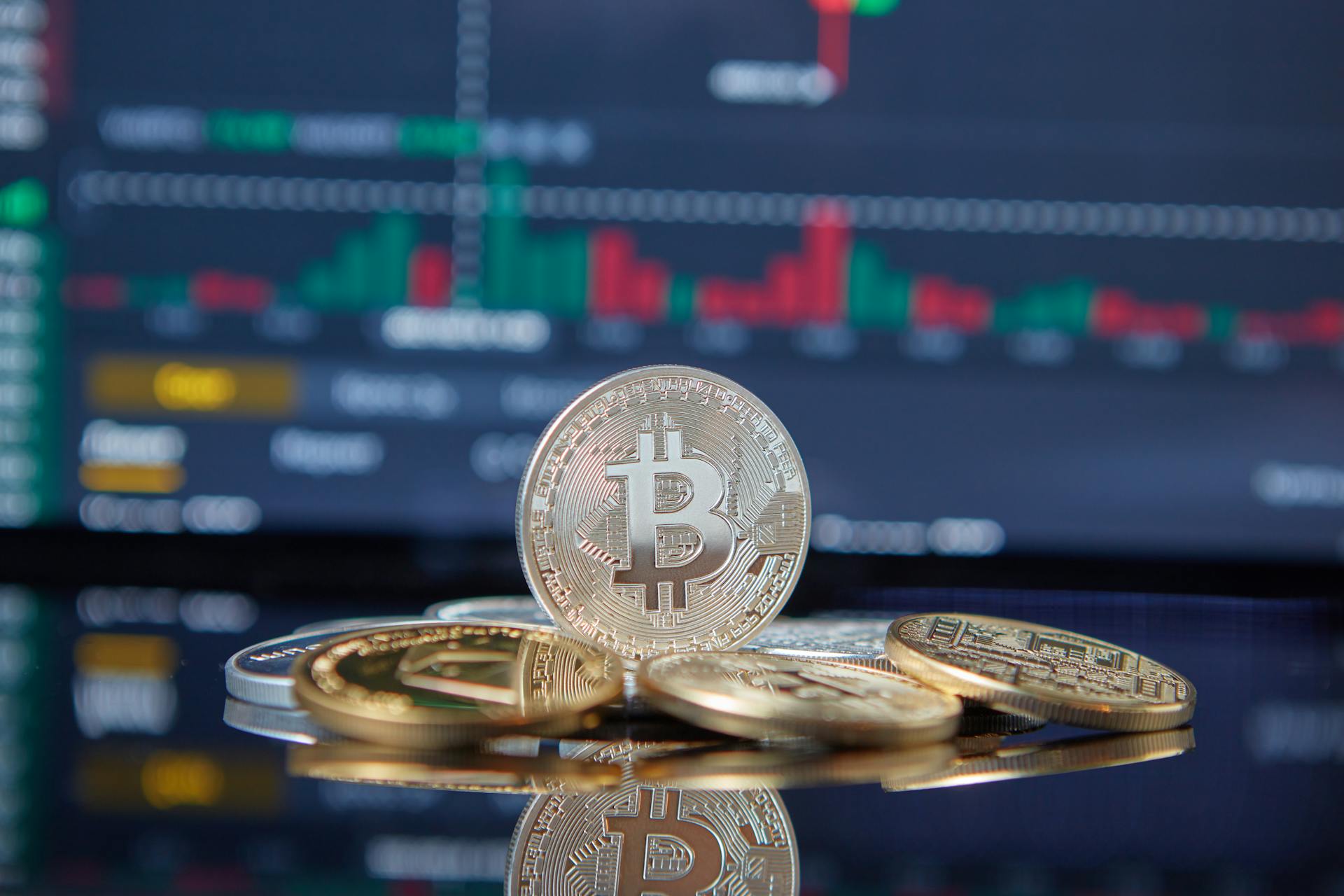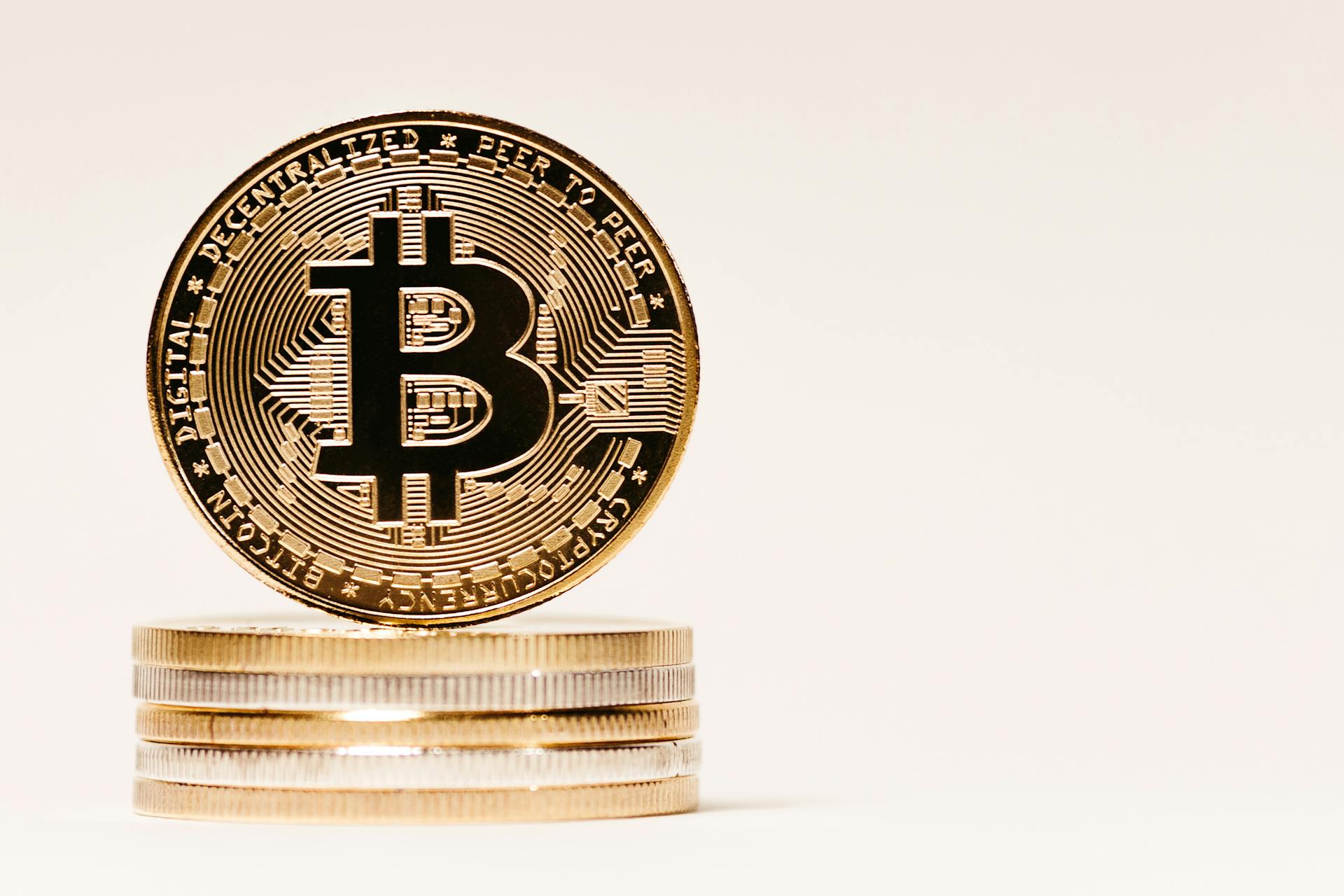
Stablecoins are designed to maintain a stable value, but their safety for long-term investment is still a topic of debate. The truth is, stablecoins are not entirely risk-free.
Most stablecoins are pegged to a fiat currency, such as the US dollar, and are backed by a combination of reserves and other assets. This means that if the value of the underlying assets were to drop, the stablecoin's value could also decrease.
However, some stablecoins have a strong track record of stability and have withstood market fluctuations. For example, USDT has maintained its peg to the US dollar despite significant market volatility.
Take a look at this: Bitcoin Atm Milwaukee - Coinhub
What Are Stablecoins?
Stablecoins are a type of cryptocurrency that's designed to minimize price volatility by being pegged to a stable asset.
The first notable stablecoin, Tether or USDT, was launched in 2014, making it a pioneering example of this concept.
Stablecoins are pegged to assets like fiat currency, precious metals, or commodities, which helps maintain their value somewhat consistently.
Traditional cryptocurrencies like Bitcoin and Ethereum are highly volatile and subject to wild price swings, making stablecoins a more reliable option.
Stablecoins like USDC and DAI have gained widespread adoption on exchanges and in DeFi protocols, which have exploded in popularity in recent years.
Today, stablecoins are used as a base currency in many cryptocurrency trading pairs, including Bitcoin/USDT and Ethereum/USDC, demonstrating their importance in the cryptocurrency market.
They're also widely used in DeFi protocols that allow users to earn interest on their cryptocurrency holdings or borrow and lend cryptocurrencies.
Related reading: Usds Stablecoin
Types of Stablecoins
Stablecoins are a type of cryptocurrency designed to maintain a consistent value, and there are several types to choose from.
Fiat-collateralized stablecoins are backed by traditional assets such as fiat currencies or commodities, providing a tangible backing to their value.
Crypto-collateralized stablecoins, on the other hand, are backed by other cryptocurrencies, which can be riskier but also offers a more decentralized option.
Algorithmic stablecoins use smart contracts and algorithms to maintain price stability, a unique approach that doesn't rely on collateral.
Each type of stablecoin has its own advantages and risks, so it's essential to understand the differences before investing in stablecoins.
Here's an interesting read: Bitcoin Atm Tampa - Coinhub
Safety and Risks
Investing in stablecoins comes with its own set of risks and rewards. The stability of stablecoins relies on the mechanisms and reserves that support them, such as fiat currencies or other cryptocurrencies.
Fiat-collateralized stablecoins, backed by traditional fiat currencies, offer a high level of stability due to their direct link to fiat reserves. However, their safety depends on the transparency and security of the reserves held by the issuer.
Transparency is a crucial element in evaluating stablecoin safety, and businesses should seek stablecoins with transparent and verifiable backing to maintain the pegged value.
Check this out: How to Transfer from Crypto Wallet to Fiat Wallet
Safety and Risks
Businesses evaluating stablecoins should prioritize transparent backing to ensure the pegged value. This involves verifying whether the stablecoin issuer provides regular audits and clear reporting on reserves.
Transparency offers reassurance that the stablecoin is properly managed and backed by sufficient assets. A lack of transparency can raise red flags and increase the perceived risk of using a particular stablecoin.
Regulatory compliance is essential for stablecoin safety, as operating within a framework that aligns with legal requirements enhances credibility and shields businesses from potential legal and financial repercussions.
Over-collateralized stablecoins, like DAI and DJED, are backed by a reserve of cryptocurrency and use overcollateralization to mitigate risks of collapse. This design is similar to algorithmic stablecoins but offers an additional layer of security.
Safety and Risks
Stablecoins can be backed by a reserve of fiat currency, such as the US dollar, and can be redeemed for the underlying fiat currency at any time.
The safety of a stablecoin depends on the transparency and security of the reserves held by the issuer, and having enough reserves is crucial to maintain stability.
One USDT equals one U.S. dollar, so the reserves should be equal to the number of stablecoins available to keep prices stable.
Companies have been accused of misusing backed reserves, putting their stablecoin at risk, and some platforms have been caught using cryptocurrencies instead of fiat currencies to back their stablecoins.
Tether was accused of using about $800 million worth of its assets to cover losses and was banned from operating in New York and fined $41 million.
Investors can pull out their money if they find out the company issuing the stablecoin isn't being transparent, which can cause a huge crash and affect the asset's value.
Fiat-collateralized stablecoins, like Tether and USD Coin, are popular examples, but their safety depends on the transparency and security of the reserves held by the issuer.
The safety of commodity-collateralized stablecoins, like those backed by gold or silver, relies on the stability and security of the commodity market.
Cryptocurrency-collateralized stablecoins, like Dai, use smart contracts to maintain the peg, but the volatility of the underlying cryptocurrencies can pose risks to maintaining the stablecoin's value.
Algorithmic stablecoins have proven to be less reliable, as seen with the TerraUSD incident, and are prone to significant risks if the algorithm fails or loses market confidence.
Additional reading: Million Bitcoins
What Defines Stability
Stability in stablecoins is defined by the type of stablecoin and the mechanism it uses to maintain its value.
Fiat-backed stablecoins are considered the most stable because they're backed by a reserve of fiat currency, which is relatively stable and less volatile compared to other assets.
The stability of a stablecoin also depends on the issuer's transparency and security of the reserves held by the issuer, as seen with fiat-collateralized stablecoins like Tether (USDT) and USD Coin (USDC).
Algorithmic stablecoins, on the other hand, use complex algorithms to regulate their supply, but they face the highest risk of depegging from their intended value, as seen with the TerraUSD incident.
Gold-backed stablecoins, like Tether Gold or XAUT, are also considered stable because they're backed by a reserve of gold, which has historically been a stable store of value.
The safety of a stablecoin, however, is defined by the level of risk associated with owning it, and fiat-backed and gold-backed stablecoins are considered safe because they're backed by a reserve of a tangible asset.
For more insights, see: Tether Stablecoin
Fiat-backed and gold-backed stablecoins reduce the risk of owning the stablecoin, but there are potential risks associated with holding stablecoins, such as the risk of fraud or default if the issuer is not transparent or trustworthy.
The risk varies depending on the issuer and the architecture of the stablecoin, and even over-collateralized stablecoins may be considered safer, but this may be theoretical as most overcollateralized stablecoins are relatively rare.
Safety and Risks
Stability is key to investing in stablecoins, but what defines stability or safety? Stability depends on the type of stablecoin and its mechanism for maintaining value.
Fiat-backed stablecoins, like Tether (USDT) and USD Coin (USDC), are considered the most stable because they're backed by a reserve of fiat currency, which is relatively stable and less volatile.
Algorithmic stablecoins, on the other hand, face the highest risk of depegging from their intended value, as seen with the TerraUSD incident.
Safety is defined by the level of risk associated with owning a stablecoin. Fiat-backed and gold-backed stablecoins are considered safe because they're backed by a tangible asset, reducing the risk of owning the stablecoin.
Intriguing read: Stablecoin Legislation
However, there are potential risks associated with holding stablecoins, such as the risk of fraud or default if the issuer is not transparent or trustworthy.
The stability of a stablecoin also depends on the transparency and security of the reserves held by the issuer, which is crucial for fiat-collateralized stablecoins like Tether (USDT).
Investing in stablecoins comes with its own set of risks and rewards, and it's essential to carefully evaluate these risks and rewards before making any investment decisions.
Fiat-backed stablecoins, like USD Coin (USDC), are considered safe because they're backed by a reserve of fiat currency, but it's essential to research the issuer and the architecture of the stablecoin to minimize risks.
The risk of owning a stablecoin varies depending on the issuer and the architecture of the stablecoin, such as the risk of holding a stablecoin backed by a low-cap cryptocurrency.
Take a look at this: Cryptocurrency Security Risks
Can Be Hacked?
Stablecoins can be hacked, which means your assets can be stolen. This can happen if your digital wallet is hacked, and your cryptocurrency exchange has flaws that hackers can exploit.
Investors often store their stablecoins in digital wallets for easy accessibility, but this increases the chances of their wallet being hacked.
Your wallet and trading platform can both be hacked, making it essential to use an insured platform like Nexo to keep your digital assets safe.
If someone accesses your private keys, they can easily transfer your stablecoins to other digital wallets.
For your interest: Cuba Digital Currency
Evaluating Safety
Stablecoin safety is determined by several critical criteria, including the backing of the stablecoin, transparency, and regulatory compliance.
Transparency is crucial in evaluating stablecoin safety, as it offers reassurance that the stablecoin is properly managed and backed by sufficient assets.
A lack of transparency can raise red flags and increase the perceived risk of using a particular stablecoin.
Regulatory compliance is also a significant aspect of stablecoin safety, as it enhances the credibility of a stablecoin and shields businesses from potential legal and financial repercussions.
Market size and liquidity are important indicators of a stablecoin's safety and reliability, with larger stablecoins generally considered more stable and less prone to market shocks.

However, market size alone does not guarantee safety, and businesses should consider other factors, such as the stablecoin's backing, transparency, and regulatory compliance, to ensure comprehensive risk management.
Having enough reserves of its backing asset stored safely is one of the most important things that determines how stable a stablecoin is.
A good example is Tether, which was accused of misusing a lot of its backed reserves, putting its stablecoin at risk.
A stablecoin with a robust market presence, combined with strong operational practices, is more likely to provide the stability businesses seek.
It's essential to look for companies that have proven they have enough collateralized assets before investing with them.
Investors can pull out their money if they find out that the company issuing the stablecoin isn't being transparent, which can cause a huge crash and affect their asset's value.
Check this out: Crypto Asset Security
Centralization vs Decentralization in Security
Centralization can offer advantages in terms of regulatory compliance and operational efficiency, but it requires users to trust the issuer's management of the reserves.
Centralized stablecoins are issued and controlled by a single entity, which manages the reserves and supply of the stablecoin. This central control can be a problem, as seen with the TerraUSD incident, where the algorithm failed and the stablecoin lost market confidence.
Decentralized stablecoins, on the other hand, operate without a single controlling entity, relying on algorithmic mechanisms and smart contracts to manage supply and value. This trustless nature can be appealing, as it reduces reliance on a central authority.
However, decentralized stablecoins are not entirely free from risks, as they can be influenced by governance models and protocols. A good example of this is Dai (DAI), a well-known cryptocurrency-collateralized stablecoin.
Businesses must assess their risk tolerance and operational needs to determine which model aligns best with their objectives. The choice between centralization and decentralization can impact trust, security, and regulatory compliance.
In fact, decentralized stablecoins like Dai can be a safer option, as they are not controlled by a single entity and can be more resilient to platform crashes, like the one that could happen to centralized platforms like USDT.
Recommended read: Decentralized Finance Courses
Binance USD (BUSD)
Binance USD (BUSD) is a Binance stablecoin with a market capitalization of $17,403,394,931.
Trading BUSD on Binance's site provides additional benefits such as better trading and lower conversion fees.
Its audits are published monthly, making BUSD highly secure and trustworthy.
Recommended read: Binance Stablecoin
Transparency
Transparency offers reassurance that the stablecoin is properly managed and backed by sufficient assets. Financial analyst Catherine Huang notes that transparency is crucial in evaluating stablecoin safety.
Regular audits and clear reporting on reserves are essential for businesses to verify a stablecoin's transparency. A lack of transparency can raise red flags and increase the perceived risk of using a particular stablecoin.
Stablecoins with transparent backing, such as fiat-collateralized stablecoins, provide a high level of stability. The safety of these stablecoins depends on the transparency and security of the reserves held by the issuer.
Transparency is a critical element in evaluating stablecoin safety, and businesses should seek stablecoins with transparent and verifiable backing. This helps maintain the pegged value of the stablecoin and provides a sense of security for users.
Curious to learn more? Check out: Cryptocurrency Security
Economic Stability
Economic Stability is a myth when it comes to stablecoins, even those backed by strong fiat currencies like the dollar.
Fiat backed stablecoins are seemingly the safest option since fiat currencies aren’t as volatile as cryptocurrencies, but they can still fluctuate or even crash if pegged to a weak fiat currency.
Stablecoins backed by superior fiat currencies are less likely to crash, but they can still lose value due to major economic events like inflation and economic instability.
You will still have the same number of stablecoins in your wallet, but you will have less money to buy things with, which is a harsh reality to face.
Economic events can cause a ripple effect, making fiat backed stablecoins lose some value until everything goes back to normal.
Mural for Enhanced Transactions
Mural offers a secure and efficient way to integrate stablecoins into payment and settlement processes. By leveraging stablecoins like USDC and USDT, Mural enables instant global payments in over 40 currencies.

One advantage of using Mural is its batch payment capability, allowing businesses to send payments to multiple recipients in a single transaction. This feature simplifies payment processes and ensures timely settlements.
Mural's invoicing service supports stablecoin payments, offering cost-effective and rapid transactions. With features like custom branding and automatic reconciliation, businesses can streamline their invoicing processes.
Mural's services make it easier for businesses to handle the complexities of stablecoin transactions while maintaining security and compliance.
Suggestion: Bitcoins Transactions per Second
Regulations and Oversight
The lack of regulations around stablecoins has made it easier for issuers to make false claims about their backing, which is a large part of what makes some of them potentially unsafe.
Regulatory oversight can enhance the credibility of stablecoins, making them more attractive to businesses. Regulations often require issuers to maintain adequate reserves, provide transparent reporting, and demonstrate technical expertise.
Some governments worry that stablecoins are being used for illegal things because they let people do business without going through banks, leading to efforts to regulate them with new laws.
Issuers who refuse or are unable to meet new regulatory requirements could see their stablecoins crash, affecting their availability and use.
The regulatory environment is still developing, and businesses must stay informed about changes that could impact stablecoin operations.
Additional reading: How to Find New Crypto Coins Early
Diversifying Your Portfolio
Diversifying your investment portfolio is an important strategy to mitigate risk and maximize returns.
Stablecoins can play a role in diversifying your portfolio by providing a stable and reliable investment option. By allocating a portion of your portfolio to stablecoins, you can balance the risk and return of your overall investment portfolio.
Stablecoins can act as a hedge against market volatility, providing stability during times of economic uncertainty. This is especially useful during times of economic downturn.
Stablecoins can be easily converted to other cryptocurrencies or fiat currencies, allowing for quick portfolio adjustments based on market conditions.
Curious to learn more? Check out: Safe Investment Vehicle
Advanced Investment Strategies
Stablecoins can be invested in through advanced strategies that offer additional income and potential capital appreciation. Staking and yield farming are two popular strategies in the world of stablecoin investment.
Staking involves holding stablecoins in a crypto wallet and earning staking rewards for participating in the network's consensus mechanism. This can provide an attractive alternative to traditional savings accounts.
Related reading: Ethereum Staking
Yield farming, on the other hand, involves providing liquidity to decentralized finance (DeFi) protocols and earning yield in the form of additional stablecoins or other tokens. It's essential to understand the complexities involved in yield farming before engaging in this strategy.
These advanced strategies can be riskier than traditional stablecoin investments, so it's crucial to do thorough research and understand the mechanisms involved.
Worth a look: Bitx Dividend Yield
Specific Stablecoins
Some stablecoins have a strong track record of stability, such as DAI, which is pegged to the US dollar and has a market capitalization of over $5 billion.
However, even stablecoins with a strong reputation can still be vulnerable to market fluctuations.
Tether, for example, is a stablecoin that claims to be pegged to the US dollar, but has been known to have issues with maintaining its peg during times of high market volatility.
USDC, on the other hand, is a stablecoin that is issued by a consortium of banks and has a strong reputation for stability and security.
You might enjoy: Stablecoins Aleph Zero 1 Dollar
Euro-Backed

Euro-Backed stablecoins are primarily used in Europe and are designed to maintain a stable value based on the price of the euro.
EURC, developed by Circle, is an example of a euro-backed stablecoin. Circle also created USDC, another type of stablecoin.
A fresh viewpoint: Euro Stablecoin
Specific Stablecoins
Tether is among the most popular stablecoins, with a market cap of $82,826,176,152. It's been around for almost a decade, giving it a solid reputation.
Tether is dollar-backed, meaning you can exchange one coin for a U.S. dollar. This provides a level of security and stability for investors.
Tether is accessible and tradeable on approximately 31 crypto lending platforms. This makes it easy to buy and sell Tether on various platforms.
USD Coin has a market cap of $50,010,212,715, making it another huge stablecoin in the crypto market. It's a close second to Tether in terms of popularity and market value.
USDC is regulated, which makes it highly reliable and transparent. This is a big advantage for investors who value security and trustworthiness.
USDC is accessible on about 34 crypto lending platforms, giving investors a wide range of options for buying and selling.
Recommended read: Lending Crypto Currency
Frequently Asked Questions
Are stablecoins safer than banks?
Stablecoins offer a safer alternative to traditional banking, backed by regulated entities and transparent proof of reserves. This makes them a more secure option, especially when compared to traditional banks.
Sources
- https://moneymade.io/learn/article/safest-stablecoin
- https://medici.bank/gb/media/what-is-stablecoin-and-how-to-invest-stablecoins-a-step-by-step-guide-2024
- https://bitcompare.net/post/are-stablecoins-safe-learn
- https://www.chainport.io/knowledge-base/are-stablecoins-safe
- https://www.muralpay.com/blog/are-stablecoins-safe-whats-the-safest-stablecoin
Featured Images: pexels.com


